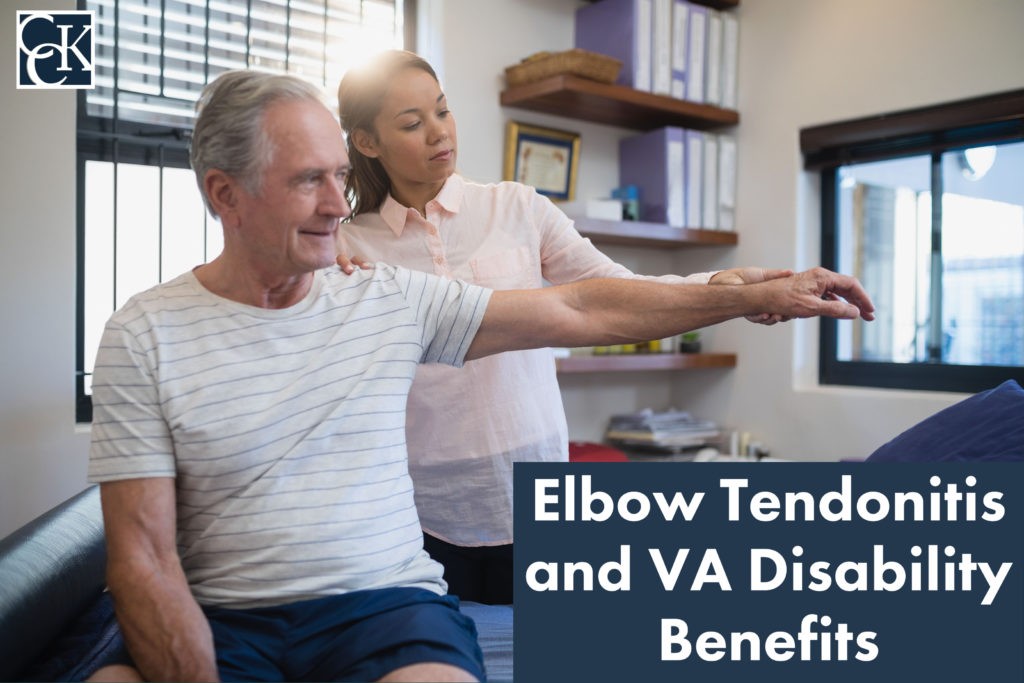Elbow Tendonitis (Tennis Elbow) and VA Disability Benefits

CCK Law: Our Vital Role in Veterans Law
What is Elbow Tendonitis?
Elbow tendonitis, more commonly referred to as “tennis elbow,” is a painful condition that occurs when tendons in an individual’s elbow are overworked, usually by repetitive motions of the wrist and arm. Individuals with jobs involving manual labor, such as plumbers, painters, carpenters, and butchers, may be susceptible to developing elbow tendonitis. Those who engage in frequent physical activity may experience this condition at higher rates as well.
Elbow tendonitis primarily produces pain where the tendons of the forearm muscles attach to the bony bump on the outside of the elbow; however, pain can also spread into the forearm and wrist. The pain and weakness described above may make it difficult to engage in activities such as:
- Shaking hands
- Gripping objects
- Turning doorknobs
- Holding a cup of coffee
Again, this condition is an overuse and muscle strain injury. Generally speaking, the cause of this condition involves repeated contraction of the forearm muscles that individuals use to straighten and raise their hands and wrists. Essentially, the repeated motions and stress to the tissue in this area may result in a series of small tears in the tendons that attach the forearm muscles to the outside of the elbow.
Elbow tendonitis is typically diagnosed during a physical examination at which point a doctor may apply pressure to the affected area or ask the individual to move their elbow, wrist, and fingers in various ways. In some cases, doctors will request X-rays or other types of imaging tests to rule out other possible conditions or causes for the pain.
Treatment for elbow tendonitis may involve over-the-counter pain medications and other self-care measures (e.g., icing, heating, brace, splint). If these measures do not work, an individual’s doctor may suggest physical therapy.
A physical therapist can teach exercises to gradually stretch and strengthen forearm muscles. Once again, if physical therapy is unsuccessful, more extreme measures may need to be taken. Additional procedures used to treat elbow tendonitis include the following:
- Injections – platelet-rich plasma, Botox, or some form of irritant (i.e., prolotherapy) may be injected into the painful tendon
Dry needling – a needle pierces the damaged tendon in many places to stimulate repair
Ultrasonic tenotomy (TENEX procedure) – under ultrasound guidance, a doctor inserts a special needle through the skin and into the damaged portion of the tendon. Ultrasonic energy is used to send vibrations through the needle in a swift manner, thereby liquifying the tissue to be suctioned out
Surgery – if symptoms have not improved after 6 to 12 months of non-operative treatment, surgery may be considered to remove damaged tissue
Veterans and Elbow Tendonitis: How to Establish Service Connection
Veterans may be susceptible to elbow tendonitis due to the variety of physical activities and labor-intensive occupational specialties that are required of them throughout service. If a veteran believes their elbow tendonitis is due to their time in service, they should consider applying for service-connected compensation. To receive disability compensation, veterans must be service-connected for a condition.
In this case, establishing direct service connection for elbow tendonitis would involve three components: (1) demonstrating a current diagnosis of elbow tendonitis; (2) showing evidence of an in-service event, injury, or illness; and (3) providing a medical nexus linking the current, diagnosed elbow tendonitis to the in-service event, injury, or illness.
Importantly, service connection for this condition may also be established on a secondary basis. That is, if a veteran is already service-connected for one condition and they believe it caused or aggravated their elbow tendonitis, then disability benefits may be warranted for the secondary condition (i.e., elbow tendonitis) as well. After establishing service connection, veterans will be rated based on the severity of their condition.
How Does VA Rate Elbow Tendonitis?
VA typically rates elbow tendonitis based on limitation of motion of the forearm, which falls under 38 CFR § 4.71a, Schedule of Ratings – Musculoskeletal System, Diagnostic Codes 5206, 5207, and 5208. The rating criteria for each is as follows:
Diagnostic Code 5206 – Forearm, Limitation of Flexion
50/40% – flexion limited to 45 degrees
- 40/30% – flexion limited to 55 degrees
- 30/20% – flexion limited to 70 degrees
- 20/20% – flexion limited to 90 degrees
- 10/10% – flexion limited to 100 degrees
- 0/0% – flexion limited to 110 degrees
Diagnostic Code 5207 – Forearm, Limitation of Extension
50/40% – extension limited to 110 degrees
- 40/30% – extension limited to 100 degrees
- 30/20% – extension limited to 90 degrees
- 20/20% – extension limited to 75 degrees
- 10/10% – extension limited to 45 degrees
Diagnostic Code 5208
For Diagnostic Code 5208, veterans will receive a disability rating of 20 percent if their forearm flexion is limited to 100 degrees and their forearm extension is limited to 45 degrees.
Importantly, the higher percentage is reserved for the dominant forearm whereas the lower percentage is reserved for the non-dominant forearm.
Bilateral Elbow Tendonitis
If veterans suffer from elbow tendonitis in both arms, they may be eligible for the bilateral factor, which increases their overall disability rating. Specifically, the bilateral factor involves an additional 10 percent that is applied to the bilateral disabilities. First, the combined rating of the two elbow tendonitis percentages would be calculated, and then an additional 10 percent would be combined to that rating.
For example, the right elbow/forearm is rated at 20 percent disabling while the left elbow/forearm is rated at 10 percent disabling. These percentages produce a combined rating of 28 percent. The bilateral factor takes 10 percent of that 28 percent, yielding 2.8, and adding that 2.8 to the 28 percent, which equals 30.8 percent. Since VA rating are rounded to the nearest 10, the veteran’s combined rating would round down to 30 percent. Our VA disability calculator can help you with combining your ratings accounting for the bilateral factor.
About the Author
Share this Post
